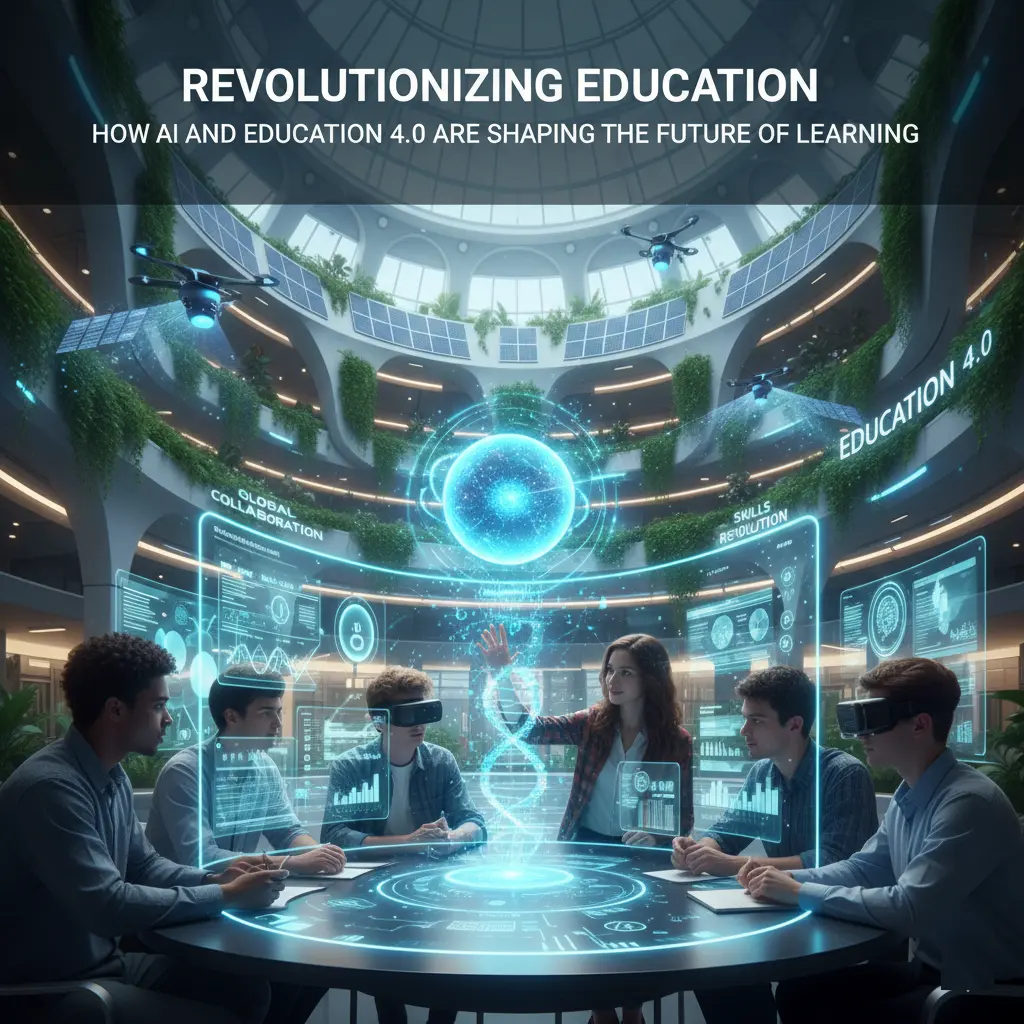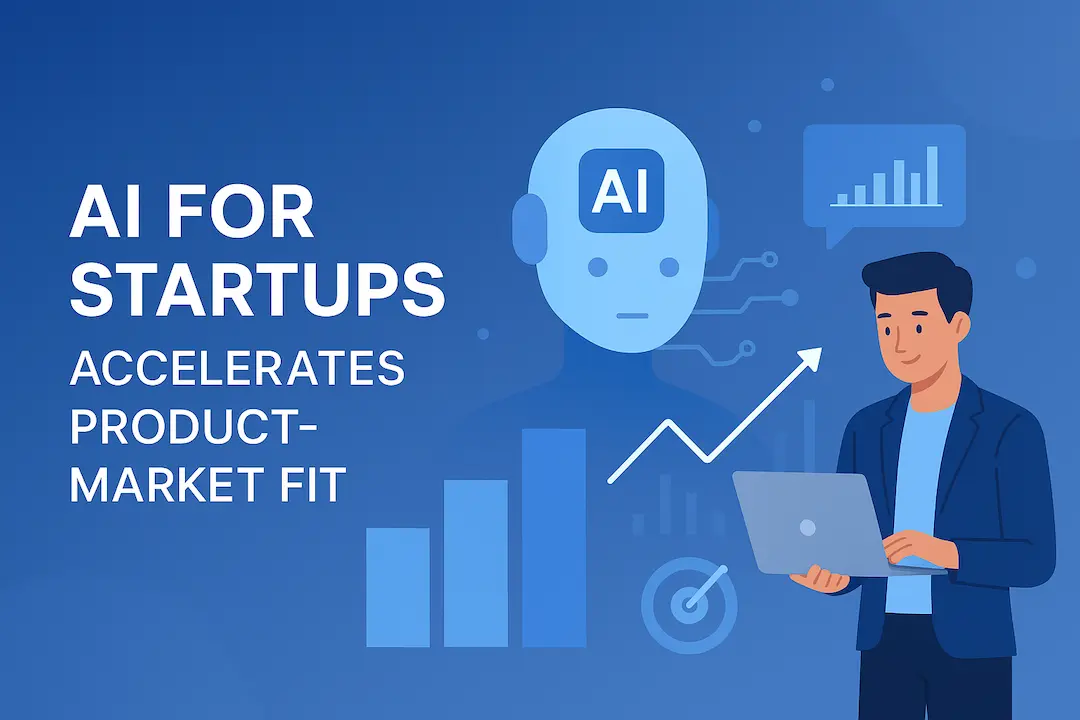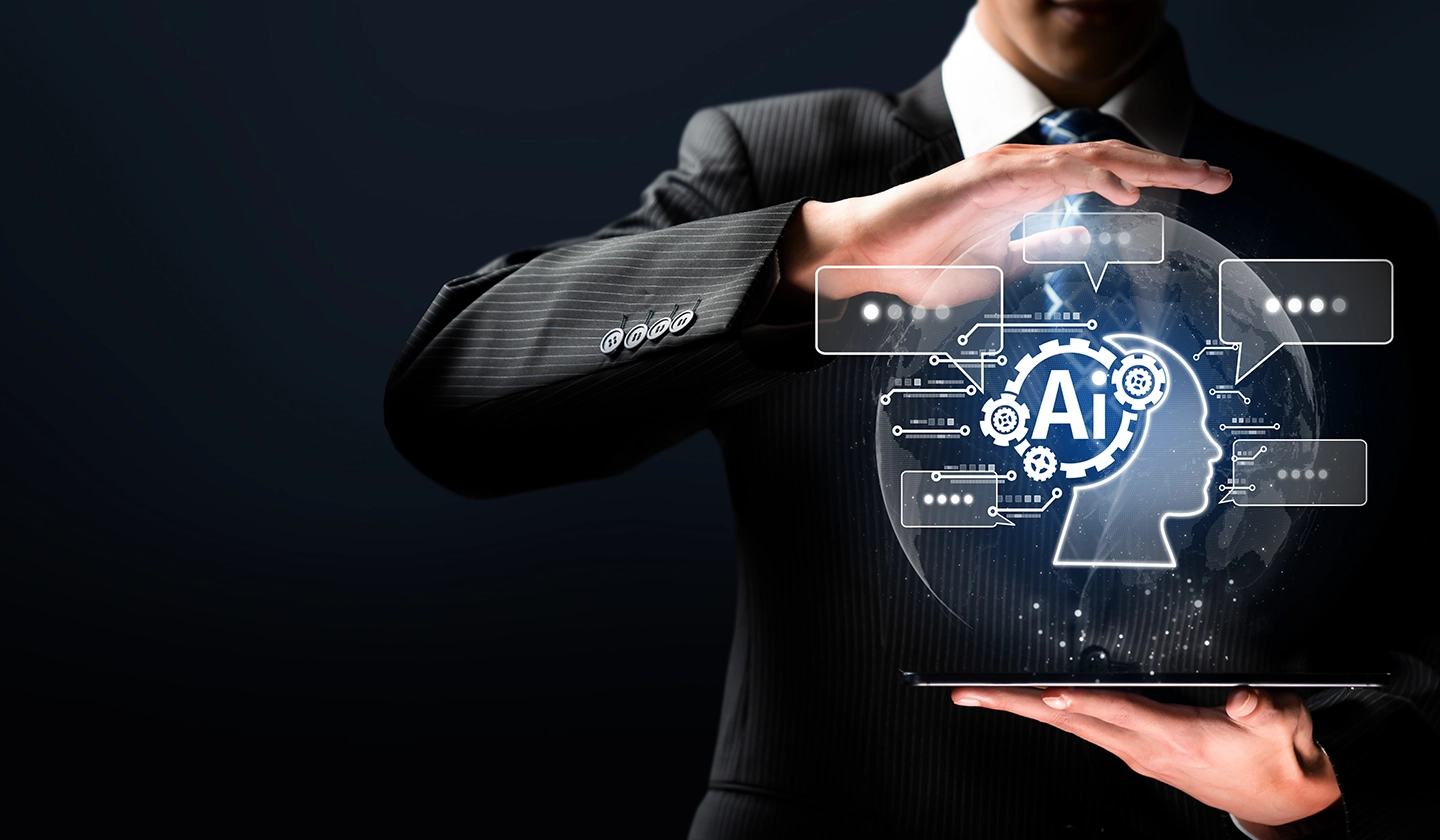
Our increasingly interconnected and rapidly evolving world means traditional education models simply can’t prepare people for tomorrow’s intricate challenges. We’re on the verge of Education 4.0, a game-changing period defined by individualized learning, adaptable routes, and a strong focus on digital literacy and vital critical thinking. This isn’t just an educational update; it’s a deep-seated transformation, reflecting the wider industrial revolution that has impacted every industry, including technology and marketing. For small tech business owners, marketing experts aged 25-45, and enterprise IT leaders, grasping this shift isn’t just theoretical; it’s vital for upcoming workforce growth, fostering innovation, and remaining competitive.
Here’s an impactful statistic: The worldwide AI in education market is set to expand from an estimated USD 4.8 billion in 2023 to USD 33.7 billion by 2032, clearly showing the massive potential and capital pouring into this area. This goes beyond adding new tech to classrooms; it’s about fundamentally rethinking teaching, learning, and preparing future generations. Artificial Intelligence (AI) sits at the core of Education 4.0, a technology ready to reshape educational encounters, making them highly adaptive, engaging, and fair. Yet, this significant transition also brings a key responsibility: the demand for mindful and ethical AI integration. We must ensure AI acts as a potent instrument to enhance human abilities, improve learning results, and close existing gaps, not widen them. This piece will explore AI’s role as Education 4.0’s foundation, examining its functions, advantages, hurdles, and the joint efforts necessary to unlock its complete capacity.
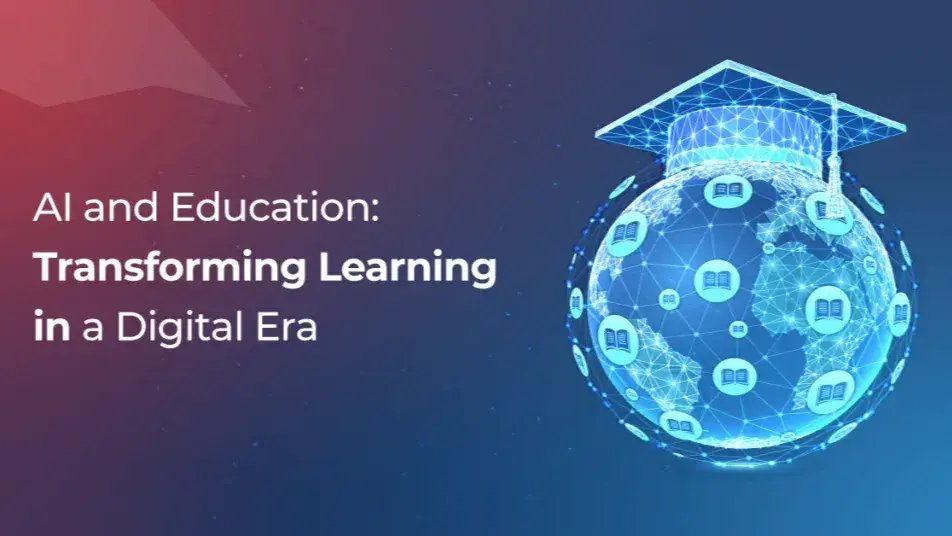
Table of Contents
- 1 The Role of AI in Education 4.0
- 2 Boosting Educational Outcomes with AI
- 3 Challenges in AI Adoption in Education
- 4 Collaborating for a Better Future
- 4.1 The Role of Stakeholders
- 4.2 Example: A Successful Partnership Case Study – ‘AI for Good’ Initiatives
- 4.3 Ensuring Equitable Access to AI in Education
- 4.4 Table 2: Key Strategies for Ensuring Equitable AI Access in Education
- 4.5 List: Resources for Educators and Institutions to Implement AI Effectively
- 5 Future Implications of AI in Education
- 6 FAQs
- 7 Conclusion
The Role of AI in Education 4.0
Education 4.0 requires flexible, vibrant learning spaces, and AI is emerging as the key driver. This isn’t about technology substituting human teachers, but rather smart systems boosting their abilities, making the learning path richer for all students, and forging a more productive, impactful educational system. The powerful blend of AI and human intellect is revealing unparalleled avenues for advancement and new ideas across educational establishments globally.
Augmenting Teachers, Not Replacing Them
The notion that AI will replace teachers is a widespread misunderstanding, especially for those new to its classroom uses. Instead, AI acts as an essential aide, managing the routine, time-consuming administrative duties that often burden educators. This liberates teachers to concentrate on their strengths: motivating, guiding, and giving individualized attention to students. Picture a future where teachers devote less effort to paperwork and more to actual teaching. That future is currently unfolding.
For example, AI-driven tools are capable of automating:
- Automated Grading: AI can rapidly assess multiple-choice questions, fill-in-the-blank exercises, and even simple essay prompts, delivering instant feedback to students and saving teachers significant time. Platforms such as Gradescope or Turnitin (with AI) streamline grading, allowing educators to focus on richer, qualitative evaluations.
- Lesson Planning & Resource Curation: AI algorithms can examine curriculum demands, student performance information, and existing materials to suggest appropriate lesson plans, activities, and extra resources customized for particular learning goals and student requirements. Tools like Curipod use AI to help teachers build engaging, interactive instruction.
- Attendance Tracking: Systems using facial recognition or RFID can automatically log attendance, cutting down on classroom interruptions and administrative burdens.
- Student Progress Monitoring: AI can follow individual student advancement through various tasks and evaluations, pinpointing areas where a student might be struggling or excelling, and highlighting these observations for the instructor. This forward-thinking method supports timely intervention and targeted help.
By transferring these repetitive duties, AI enables educators to pour more energy into intricate teaching methods, emotional backing, and cultivating critical thought—elements demanding human insight and compassion.
Enhancing Student Engagement
True engagement forms the bedrock of successful learning. A student who isn’t engaged probably won’t grasp information or cultivate a true interest in the topic. AI’s capacity to craft lively, interactive, and customized learning experiences is revolutionary for increasing student involvement and drive. When education feels custom-fit, pertinent, and reactive, students become far more inclined to actively participate.
Think about how adaptive learning platforms perform; they adjust content difficulty and speed based on a student’s live progress. If a student quickly masters a concept, the AI advances them; if they struggle, it offers extra materials and practice. This bypasses the typical “one-size-fits-all” method that frequently leaves some students bored and others feeling swamped.
Case Study: ‘MindSpark’ in Indian Schools
A prime illustration of AI boosting student engagement stems from India, where ‘MindSpark,’ an adaptive learning platform, was rolled out in numerous schools. Created by Educational Initiatives, MindSpark employs AI to provide individualized learning paths in math and language. Students engage with the system, which continually evaluates their comprehension and offers exercises and insights crafted for their particular learning deficiencies. Early findings revealed a marked improvement in academic achievements and, notably, higher student motivation. Students reported greater control over their studies and valued the instant feedback, which resulted in better attendance and a more positive outlook on difficult subjects. This program demonstrated how AI can foster a more vibrant, interactive classroom setting, turning students into active learners instead of mere information receivers.

Boosting Educational Outcomes with AI
Any educational improvement ultimately aims to enhance learning results. AI’s strengths go well past administrative support; it provides potent mechanisms for grasping unique learning styles and delivering precise interventions, thereby improving education’s overall caliber. For small business leaders and IT strategists, this directly means a future workforce that is more skilled and flexible.
Data-Driven Insights for Personalized Learning
Historically, grasping a student’s learning trajectory often relied on a teacher’s qualitative judgment and intuition. Now, AI-powered analytics offer educators detailed, data-informed insights into student achievement, learning approaches, and engagement levels. This rich trove of data forms the bedrock for truly individualized learning experiences. AI effectively discerns patterns in how students interact with course materials, pinpointing where they encounter difficulties and which instructional methods prove most effective for each individual.
Crucial uses of data-driven insights include:
- Predictive Analytics: AI can anticipate which students face a risk of falling behind, enabling educators to step in proactively before challenges become too great.
- Customized Content Delivery: Utilizing performance data, AI can suggest particular learning modules, videos, articles, or practice exercises that match a student’s distinct requirements and preferred learning styles (visual, auditory, kinesthetic).
- Real-time Feedback Loops: AI-enabled systems provide instant feedback on assignments, helping students recognize errors and learn from them immediately, instead of awaiting a teacher’s evaluation.
Table 1: Impact of AI-Driven Personalized Learning on Student Outcomes
| Outcome Metric | Traditional Learning Environment | AI-Enhanced Personalized Learning | Improvement % (Illustrative) |
|---|---|---|---|
| Student Engagement | Moderate | High | 20-30% |
| Academic Performance (Grades) | Variable | Consistently Improving | 15-25% |
| Completion Rates (Courses) | Standard | Higher | 10-18% |
| Skill Retention | Good | Excellent | 12-20% |
| Teacher Efficiency | Standard | Significantly Enhanced | 25-35% |
Statistics: A study in the Journal of Educational Technology & Society (2020) revealed that students on AI-driven personalized learning platforms, on average, scored 17% higher in assessments than control groups. A separate Brookings Institute report emphasized that personalized learning methods, often supported by AI, can yield learning benefits equal to several extra months of K-12 schooling. These numbers highlight AI’s game-changing capacity for academic success.
Bridging the Digital Skills Divide
The digital skills gap worries businesses and governments globally. As technology quickly evolves, the need for people skilled in coding, data analysis, cybersecurity, and AI literacy surpasses the available talent. Education 4.0, bolstered by AI, presents a distinct chance to tackle this vital problem by weaving digital fluency and advanced tech skills directly into lessons. This is especially pertinent for technologically adept marketing professionals and IT decision-makers who recognize the urgency of having a digitally capable workforce.
AI can close this gap through:
- Accessible Online Learning: AI-fueled platforms can provide excellent digital skills training to distant or overlooked communities, breaking down geographical obstacles.
- Adaptive Skill Development: AI tutors can coach students through coding tasks, data science initiatives, and even AI ethics debates, adjusting to their speed and giving instant, useful feedback.
- Virtual Labs and Simulations: Intricate technical abilities, like responding to cybersecurity incidents or managing networks, can be taught via AI-powered simulations, giving practical experience without costly physical setups.
Example: Cases of Schools Successfully Integrating AI to Enhance Skill Development
In the U.S., programs like ‘AI for K-12‘ seek to establish national AI education standards, with some districts already testing pilot initiatives. For example, the MIT RAISE initiative supplies materials and curricula to introduce AI ideas to K-12 students, utilizing AI tools to simplify complex computational thinking. Likewise, online platforms such as Codecademy and Coursera employ AI algorithms to suggest courses and projects based on a learner’s career aspirations and existing skill profile, making advanced digital skills more accessible to a wider audience. These cases show a forward-thinking method for readying students for a tech-driven future, ensuring they gain not just digital literacy but also the analytical and problem-solving talents required to prosper.
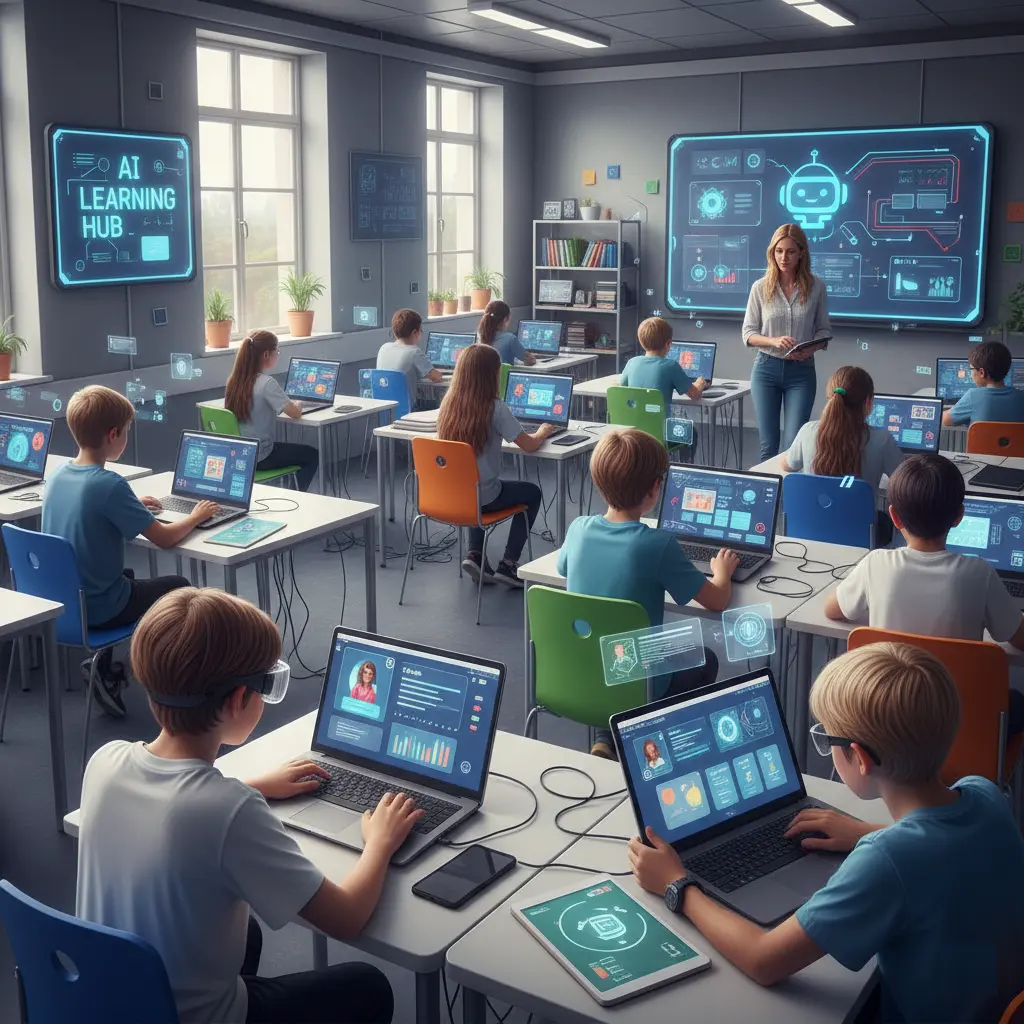
Challenges in AI Adoption in Education
Although AI’s advantages in education are undeniable, its broad and fair implementation faces considerable obstacles. Tackling these issues demands thoughtful strategizing, targeted funding, and a cooperative mindset from all involved parties. Small business proprietors and corporate IT leaders need to understand these difficulties when contemplating future collaborations or employee growth strategies.
Addressing Teacher Shortages
Our global education system contends with ongoing teacher shortfalls, a predicament worsened by elements like poor wages, heavy duties, and insufficient resources. Introducing AI, while hopeful, could unintentionally complicate matters if not approached prudently. There’s a worry that requiring teachers to master new AI tools might overextend an already taxed workforce.
LSI Keywords: teacher shortages, educational workforce, AI integration, professional development, educator training, retention strategies.
To effectively tackle teacher shortages amidst AI integration, we must prioritize:
- Targeted Professional Development: Investing in thorough training courses that equip existing educators to skillfully utilize AI tools, thus lessening the learning curve and making AI a facilitator, not an an added strain.
- Reducing Administrative Load: Emphasizing AI’s capacity to substantially lessen administrative tasks, which can ease fatigue and enhance the appeal of teaching.
- Attracting New Talent: Demonstrating how AI integration can render teaching a more inventive, stimulating, and influential profession, drawing in fresh talent eager for forward-thinking education.
- Rethinking Ratios: Investigating how AI can manage bigger class sizes while sustaining individualized learning, possibly easing the direct effect of personnel gaps.
By deliberately presenting AI as a means of assistance and improvement, rather than another chore, we can transform the challenge of teacher shortages into a chance to reshape the educator’s role.
Overcoming Economic Barriers
Deploying advanced AI tools frequently demands extensive resources, creating a substantial financial hurdle for many educational establishments, especially those in disadvantaged areas. Financing personalized AI-driven learning necessitates considerable outlays for hardware, software, infrastructure (dependable internet access), and continuous technical assistance. For IT leaders, grasping the total cost of ownership (TCO) is crucial.
This financial gap risks broadening the digital divide, forming a two-tier educational system where well-resourced institutions flourish with AI, while others fall behind. To avert this, forward-thinking actions are vital.
List: Potential Funding Sources or Grants for Schools
Here are some ways for schools and districts to obtain funding for AI integration:
- Government Grants:
- State & Local Government Funds: Numerous states and municipalities provide grants for tech enhancements and digital literacy programs.
- Corporate Partnerships & CSR Initiatives:
- Tech Companies: Major tech corporations often have corporate social responsibility (CSR) programs that finance educational technology, especially in areas tied to their main operations (e.g., Google for Education, Microsoft’s AI for Good).
- Local Businesses: Small tech sector business owners might be keen to sponsor or collaborate with local schools on AI pilot schemes, offering both monetary and expert help.
- Educational Foundations & Non-Profits:
- Groups committed to advancing education and technology (e.g., Bill & Melinda Gates Foundation, Chan Zuckerberg Initiative) regularly provide grants and aid.
- Philanthropic Donations:
- Community figures, former students, and private philanthropists can be key funding sources, particularly for groundbreaking projects.
- Cost-Sharing Models & Open-Source Solutions:
- Investigating cooperative purchasing deals among school districts or utilizing open-source AI educational tools can cut down individual institutional expenses.
By varying funding approaches and nurturing public-private collaborations, schools can overcome financial obstacles and guarantee fair access to AI-supported learning.
Collaborating for a Better Future
AI’s revolutionary power in education will only be fully achieved through a synchronized, cooperative endeavor among various stakeholders. No lone party—be it government, industry, or an educational body—can spearhead this transformation by itself. A cohesive strategy is crucial to construct an inclusive, inventive, and efficient Education 4.0 environment.
The Role of Stakeholders
Successful AI integration into education demands a coordinated collaborative effort. Every stakeholder holds a vital part in shaping learning’s future, guaranteeing AI benefits students, educators, and society broadly.
- Businesses (Tech Sector & Others): As creators of AI technologies, businesses are responsible for crafting ethical, intuitive, and impactful educational tools. They can contribute expertise, funding, and pilot schemes, aligning their innovations with actual educational demands. Small tech business owners can offer custom solutions and nimble development assistance.
- Governments: Policymakers are essential for establishing clear regulations, funding programs, and fostering fair access to technology and digital literacy initiatives. They must cultivate an environment ripe for innovation while protecting privacy and upholding ethical principles.
- Educators & Institutions: Teachers, administrators, and researchers operate on the frontline. Their understanding is critical for designing AI tools that truly enhance learning and instruction. They must be equipped with professional growth opportunities and given a say in the development process.
- Parents & Students: As the ultimate users, their input is indispensable. Students ought to be included in co-creating learning experiences, and parents must be kept informed and actively involved in the AI adoption journey.
Example: A Successful Partnership Case Study – ‘AI for Good’ Initiatives
Many major tech firms have initiated “AI for Good” projects extending into education. For instance, Microsoft’s AI for Accessibility program partnered with educational institutions to devise AI-driven tools aiding students with disabilities, such as live captioning and smart dyslexia assistance. This collaboration includes:
- Microsoft: Contributing AI research, development assets, and technical know-how.
- Universities/Schools: Supplying authentic testing environments, teaching insights, and student feedback.
- Non-profit Organizations: Serving as intermediaries, championing specific requirements, and enabling deployment in varied educational contexts.
This diverse stakeholder model ensures AI solutions are not only technologically sophisticated but also instructionally solid, ethically sound, and genuinely advantageous for diverse learners.
Ensuring Equitable Access to AI in Education
The digital divide—the disparity between those with and without modern information and communication technology access—remains a persistent issue. Without deliberate action, AI in education risks intensifying this gap, creating deeper inequalities. Guaranteeing fair access involves more than simply supplying devices; it means ensuring dependable internet, pertinent content, and the skills to effectively use these tools. This is a crucial concern for IT decision-makers focused on widespread inclusion.
Table 2: Key Strategies for Ensuring Equitable AI Access in Education
| Strategy | Description | Target Audience/Benefit |
|---|---|---|
| Infrastructure Investment | Government and private sector investment in broadband internet and device provision in underserved areas. | Rural schools, low-income communities, students without home internet. |
| Open-Source AI Tools | Promotion and development of free, customizable AI learning platforms and resources. | Schools with limited budgets, educators seeking flexible solutions. |
| Teacher Training Programs | Comprehensive, subsidized training for educators on AI literacy and tool integration. | All teachers, particularly those in under-resourced schools, to reduce tech anxiety. |
| Community Learning Hubs | Establishing public access points (libraries, community centers) with AI resources and support. | Students and families lacking home access, fostering collaborative learning. |
| Policy & Regulation | Government policies that mandate equitable access and provide funding mechanisms for disadvantaged schools. | All students, ensuring systemic support and preventing further digital disparity. |
List: Resources for Educators and Institutions to Implement AI Effectively
- UNESCO’s ‘AI and Education’ Reports: Offers global frameworks, ethical guidelines, and actual examples for responsibly integrating AI.
- ISTE (International Society for Technology in Education): Provides standards, professional development, and resources for educators utilizing technology, including AI.
- Khan Academy & Coursera: Deliver free and affordable courses on AI literacy, data science, and related areas for both instructors and students.
- Google for Education: Supplies various tools, resources, and training schemes designed to help schools incorporate Google’s AI-powered services.
- Local Tech Hubs & Universities: Frequently host workshops, seminars, and collaborative initiatives that can assist schools with AI adoption.
By proactively addressing these matters, we can ensure AI serves as a tool for empowerment and equality, rather than widening existing divides.
Future Implications of AI in Education
Looking forward, AI’s path in education suggests a future where learning closely intertwines with the needs of a swiftly evolving job market. For marketing specialists and IT leaders, grasping these consequences is vital for building talent pools and encouraging ongoing creativity within their companies.
Shaping the Workforce of Tomorrow
The abilities necessary for success in tomorrow’s professional landscape diverge significantly from those valued historically. Repetitive, rule-driven tasks are increasingly automated, elevating human-centered skills such as critical thought, innovation, emotional awareness, and intricate problem-solving to supreme importance. AI in education is perfectly placed to nurture these talents, readying students not only for current positions but also for roles yet to be imagined.
How AI equips students for future career requirements:
- Adaptive Skill Development: AI platforms pinpoint skill gaps instantly and suggest tailored learning routes to close them, guaranteeing students are continuously building pertinent capabilities.
- Project-Based Learning: AI can enable sophisticated, interdisciplinary projects that simulate real-world situations, promoting teamwork, critical reasoning, and iterative problem-solving—traits highly prized in evolving workplaces.
- Exposure to AI & Data: Weaving AI literacy into the curriculum ensures students grasp how to collaborate with AI, interpret data, and make well-informed choices, vital for any contemporary professional role.
- Soft Skills Enhancement: AI-driven simulations and virtual reality settings can help students refine communication, leadership, and ethical judgment in secure, beneficial environments.
Example: Insights from Industry Experts on Required Skills
Sector leaders consistently underscore the move towards human-focused skills. Satya Nadella, CEO of Microsoft, often points out the significance of empathy, creativity, and working with AI. Ginny Rometty, former CEO of IBM, underlined the demand for “new collar” skills—hybrid roles blending technical and interpersonal abilities. These specialists foresee a future workforce that is not merely technically competent but also flexible, inventive, and ethically principled. AI in education can directly meet these demands by cultivating a learning atmosphere that values critical thought above memorization and practical application over abstract theory.
FAQs
What is Education 4.0?
Education 4.0 represents a modern learning framework that addresses the requirements of the Fourth Industrial Revolution. It highlights tailored, adaptable, and inclusive educational experiences, utilizing technologies such as AI, big data, and virtual reality to equip students with vital 21st-century capabilities like critical thought, creativity, teamwork, and digital fluency.
How does AI improve student engagement and learning?
AI enhances student engagement by delivering customized learning paths, adjusting content complexity to individual requirements, giving instant feedback, and developing interactive learning settings. This personalization boosts learning’s relevance and motivation, leading to deeper comprehension and superior knowledge retention.
What challenges does AI face in integrating with traditional education systems?
Significant hurdles involve financial obstacles (implementation costs), the digital disparity (uneven access to technology and internet), the requirement for thorough teacher training, worries about data privacy and algorithmic prejudices, and opposition to change within established educational frameworks.
How can schools overcome the digital skills gap?
Schools can bridge the digital skills gap by embedding AI literacy and computational thinking into their curricula, providing adaptive online learning platforms for technical proficiency, employing virtual labs for practical experience, and collaborating with industry to gain resources and specialized knowledge. Investing in teacher training for digital tools is equally essential.
Conclusion
The merging of AI and Education 4.0 is far more than a mere technological progression; it represents a deep societal transformation redesigning the very bedrock of learning. From bolstering the abilities of committed educators and tailoring student experiences, to closing vital skill gaps and nurturing a workforce prepared for tomorrow, AI proves to be an indispensable asset in our educational toolkit. Although hurdles like fair access, financial constraints, and the demand for ongoing professional growth are considerable, they are not insurmountable.
By adopting a cooperative mindset, cultivating robust collaborations among businesses, governments, and learning institutions, and committing to ethical, inclusive AI implementation, we can unlock a future where education is more captivating, impactful, and available to all. The capacity for AI to spread knowledge, ignite creativity, and enable every learner to fulfill their ultimate potential is vast. For small business leaders, marketing experts, and IT decision-makers, comprehending and contributing to this advancement is not simply good policy—it’s crucial for constructing a robust, proficient, and inventive society. Let’s jointly advocate for a future where AI and education collaborate to enlighten the path for coming generations.
Ready to bring your digital vision to life? At Webologists, we blend strategy, creativity, and cutting-edge technology to build websites, apps, and AI solutions that drive real growth. Whether you’re scaling your startup or modernizing your enterprise, our team is here to turn ideas into impact. Let’s create something extraordinary — book a free consultation today and start building your next big success.
FAQs
-
What is Education 4.0?
Education 4.0 represents a modern learning framework that addresses the requirements of the Fourth Industrial Revolution. It highlights tailored, adaptable, and inclusive educational experiences, utilizing technologies such as AI, big data, and virtual reality to equip students with vital 21st-century capabilities like critical thought, creativity, teamwork, and digital fluency.
-
How does AI improve student engagement and learning?
AI enhances student engagement by delivering customized learning paths, adjusting content complexity to individual requirements, giving instant feedback, and developing interactive learning settings. This personalization boosts learning’s relevance and motivation, leading to deeper comprehension and superior knowledge retention.
-
What challenges does AI face in integrating with traditional education systems?
Significant hurdles involve financial obstacles (implementation costs), the digital disparity (uneven access to technology and internet), the requirement for thorough teacher training, worries about data privacy and algorithmic prejudices, and opposition to change within established educational frameworks.
-
How can schools overcome the digital skills gap?
Schools can bridge the digital skills gap by embedding AI literacy and computational thinking into their curricula, providing adaptive online learning platforms for technical proficiency, employing virtual labs for practical experience, and collaborating with industry to gain resources and specialized knowledge. Investing in teacher training for digital tools is equally essential.


